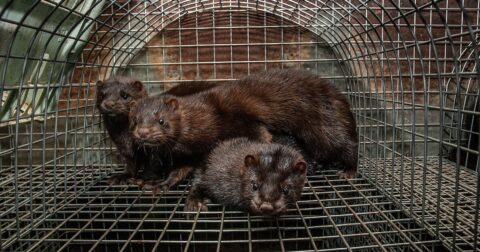News
New York Bill Aims to Ban New Mega-Dairies
Law & Justice•6 min read
Perspective
Massive outbreaks of COVID-19 led to the permanent closure of fur farms in the Netherlands, Poland, and France, but the U.S. has yet to take action.


Words by Devatha P. Nair
On a fur farm in Utah, a small white mink frantically chews the wire bars of a cage so small that he can barely take more than a couple of steps. As a semi-aquatic, habitually territorial, and solitary animal by nature, living in a cage with three other minks causes him intense distress. Unable to escape these unnatural conditions, he attacks his fellow inmates and displays self-destructive behavior by chewing on his tail. At seven months old, he is slaughtered along with his cage-mates via genital electrocution to preserve his skin.
In factory farms, it is standard practice to breed animals in cramped, unhygienic conditions that make them susceptible to disease, as evidenced by the spread of COVID-19 in fur farms. Over one million fur animals were killed last year to prevent the spread of COVID-19. Acknowledging animal cruelty concerns and threats to public health, fur-producing nations such as the Netherlands, Poland, and France have begun announcing the permanent closures of fur farms. Countries that have long banned fur farms, such as the UK, are now moving towards restrictions on fur sales. In June of 2021, Estonia became the latest country to ban fur farming, joining the likes of Austria, Belgium, Croatia, Slovenia, Bosnia and Herzegovina, Serbia, Macedonia, and Norway. Despite outbreaks of COVID-19 in fur farms in Utah and evidence of animals being maintained in unsanitary and inhumane conditions, the U.S. has yet to take action on this issue.
More than 240 mink farms, spread across 22 states in the U.S., form part of a global market in which minks, foxes, chinchillas, bob-cats, and rabbits are bred and slaughtered for collar trims, trinkets, and coats. Up to 85 percent of the global supply of fur comes from factory farms, and more than 100 million animals are killed each year for fur. Over 10 million fur animals are also trapped in the wild. A truly global enterprise, fur farms are located throughout the world, driven by consumer demands for utilitarian and exotic garments.
Animals bred for slaughter on fur farms lead short, pain-filled lives. Crowded within small wire cages, they live in close proximity to their own urine and feces. Removed from their natural environments, they display stress-induced behavioral abnormalities such as cannibalism and self-mutilation. As slaughter techniques on fur farms prioritize preserving the animals’ skins, death occurs by genital electrocution, neck-breaking, or suffocation in make-shift gas chambers. Fur farms, like all forms of animal agriculture, are profit-driven entities.
Animals trapped for fur in the wild also endure painful, premature deaths. Traps crush parts of the animals’ bodies, causing open wounds and broken bones. Unable to fend off attacks, trapped animals are easily killed by other non-human predators. Traps are checked at widely differing frequencies, routinely causing animals to die from loss of blood and starvation in the interim. Those who survive in the traps are killed by stomping, choking, or bludgeoning.
On fur factory farms, systematically breeding, slaughtering, and processing animals also harms the environment. A single animal on a fur farm can generate up to 44 pounds of feces each year, contributing to the 100 million pounds of fecal waste generated annually in the U.S. Mink waste, which contains high concentrations of phosphorus and nitrogen, is often used as manure—polluting soil, streams, and lakes, and hampering the ability of these ecosystems to sustain life. The pollution from ammonia, chromium, and bleaching agents used to process fur places the fur industry among the top five toxic-metal polluters in the world. The incineration of animal carcasses is a major source of air pollutants in the vicinity of fur farms. Operating fur factory farms are detrimental to animals and the environment, too.
Fur farms in the U.S. are protected by a lack of legally binding federal legislation. Classified as “farm animals used for food or fiber (fur, hide, etc.),” fur species are excluded from the Animal Welfare Act—a law that addresses the treatment of only specific classes of animals, such as those exhibited to the public or used in research. The United States Department of Agriculture no longer reports the number of U.S. fur farms, claiming a need to protect the identities of farmers. Lack of enforcement of and vague language in state guidelines enable fur farms to operate largely unhindered by state laws; state-level regulations on trapping wild animals for fur are rarely enforced and vary widely from state to state. The widespread lack of uniform, meaningful regulations, and enforcement is failing to protect animals from the profit-driven motives of the fur industry.
Breeding, trapping, and slaughtering animals for fur perpetuates the cycle of pain-filled lives and early deaths for these animals. In the interest of profit, the suffering that animals farmed and trapped for fur endure is often hidden from consumers—a largely successful strategy, given that fur continues to be a staple of fashion industry trends. But contemplating the unnatural existences to which we subject other animals should not require the advent of a pandemic such as COVID-19 and its associated mass cullings. In a world awash with natural and synthetic garments that do not require exploiting our fellow sentient beings, many alternatives exist to keep us fashionable and warm.